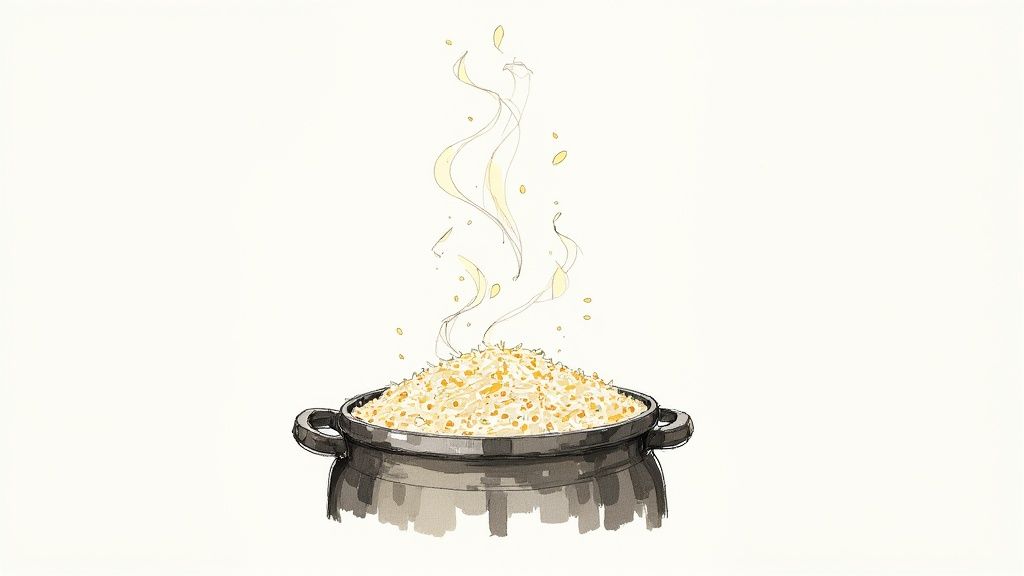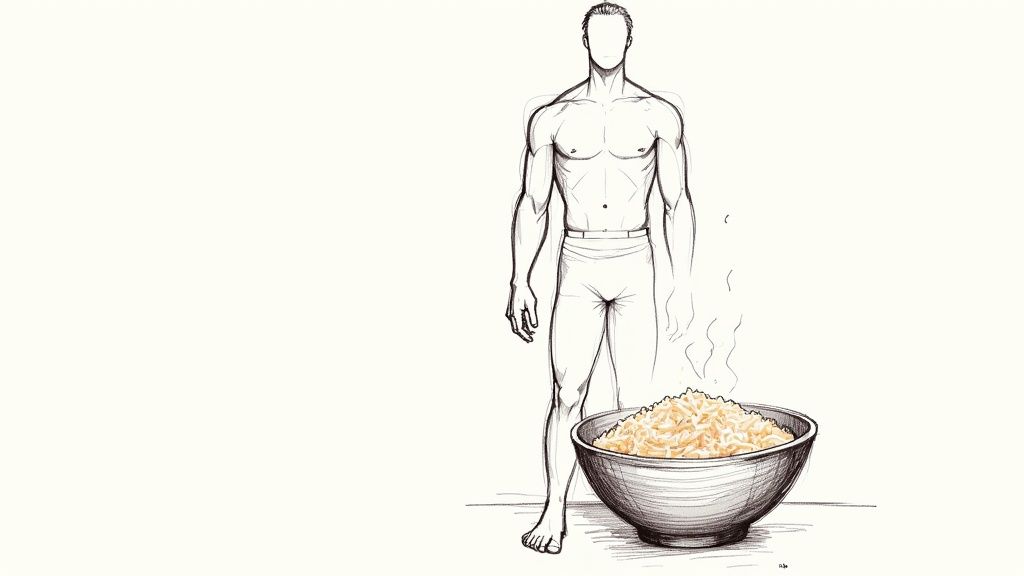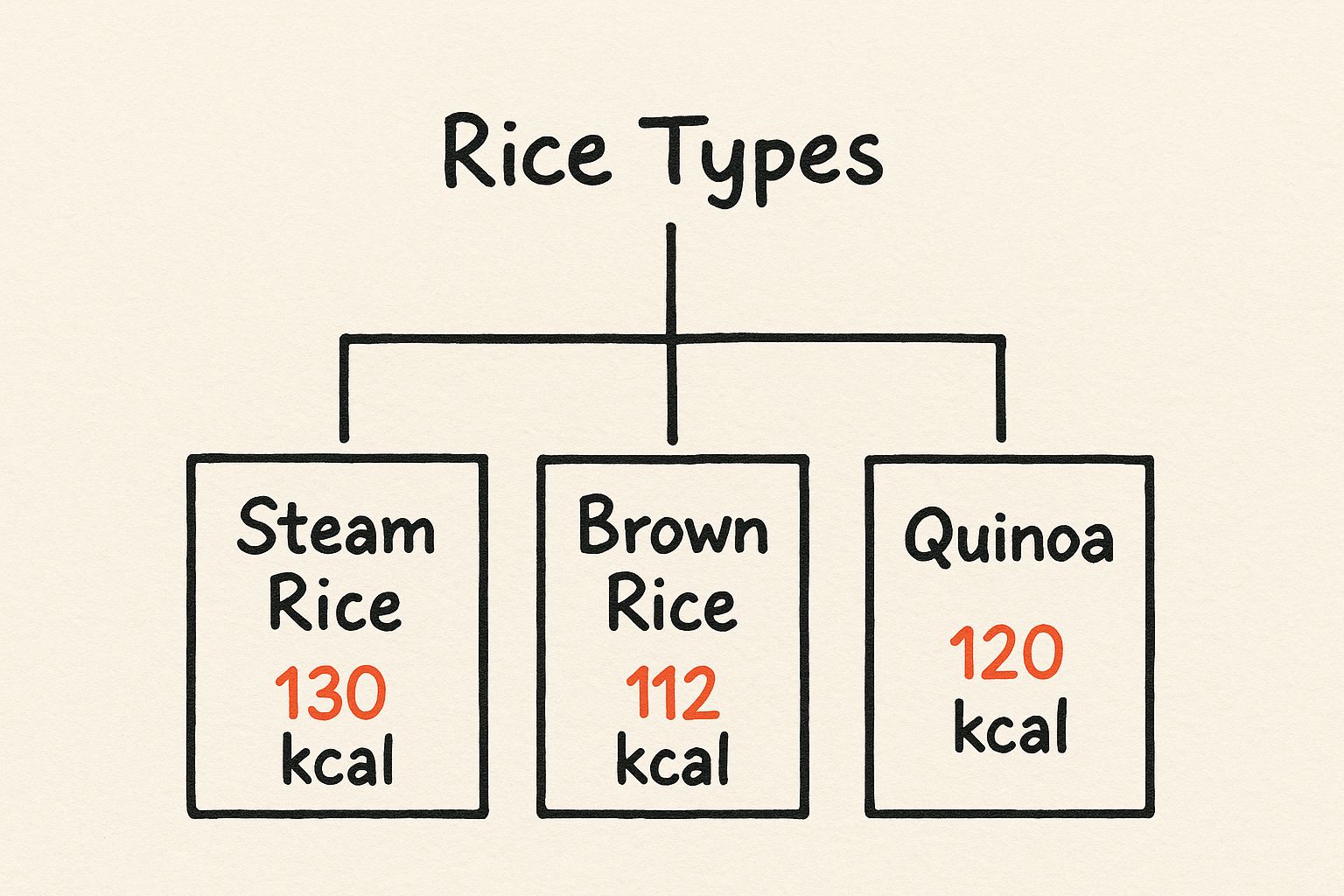Is Steam Rice Healthy? A Simple Guide to Your Favorite Grain
Wondering if steam rice is healthy? Discover if steam rice is healthy, along with nutritional insights and tips for a balanced diet.
Posted by
So, is steamed rice actually good for you? Let's clear the air: absolutely. It’s a simple, clean fuel source that powers billions of people every single day. Instead of getting stuck on whether a food is "good" or "bad," it's way more helpful to see it as a piece of the puzzle in your overall eating habits.
The Simple Truth About Steamed Rice

Think of steamed rice as a reliable, low-fat energy source. It’s the perfect blank canvas for building a tasty and nutritious meal. Since it’s steamed, not fried, you skip the extra fats and oils, keeping things clean and simple.
This straightforward cooking method is a huge reason why it's a staple for so many cultures around the world.
Why Steaming Matters
Steaming is a gentle way to cook that helps lock in nutrients without adding extra calories from fat. It's the go-to preparation for a grain that provides energy for over 3.5 billion people.
This cooking process also helps the rice hang on to important B vitamins like thiamin and niacin, which are crucial for keeping your energy levels up. You can discover more insights about rice production and consumption from the USDA if you want to geek out on the details.
The key is to see rice not as a standalone hero or villain, but as part of a balanced team. Pairing it with protein, healthy fats, and veggies transforms it into a complete and satisfying meal.
When you see it this way, you can enjoy rice without any guilt. It also makes tracking your meals so much easier. Instead of stressing over a scoop of rice, you can just tell your munchlog.ai app, "I had grilled chicken with steamed rice and broccoli." Easy.
That kind of relaxed approach makes it a breeze to stay mindful of your nutrition without the pressure of being perfect. It’s all about looking at the big picture of your daily habits, one simple meal at a time.
To wrap it up, here’s a quick breakdown of what makes steamed rice a solid choice for your plate.
Steamed Rice At a Glance
| Nutritional Aspect | Why It Matters for Your Health |
|---|---|
| Clean Energy Source | Provides carbohydrates for immediate energy without unhealthy additives. |
| Low in Fat | Steaming avoids added oils, supporting heart health and weight management. |
| Easily Digestible | Gentle on the stomach, making it a great option for refueling after a workout. |
| Nutrient Preservation | The steaming process helps retain B vitamins essential for energy metabolism. |
| Versatile Base | Pairs perfectly with proteins, fats, and veggies for a complete meal. |
Ultimately, steamed rice is a fantastic component of a healthy, balanced diet.
Understanding What's in Your Bowl of Rice

So, when you scoop up a spoonful of fluffy steamed rice, what are you actually putting into your body? Let's get straight to it. The headliner here is carbohydrates, which are your body's number one fuel source.
Think of carbs as the gas for your engine. They give your brain the energy it needs to stay sharp and your muscles the power to move, whether you're lifting weights or just walking up a flight of stairs. It's a foundational food for a reason!
The Macro Breakdown
But rice isn't just a one-trick pony. While it's carb-heavy, it also brings a bit of protein to the table, helping you feel more satisfied after a meal. Better yet, it's naturally very low in fat and completely cholesterol-free, which makes it a fantastic lean energy source.
Let's look at the numbers. A standard 100-gram serving of cooked white rice (that's about half a cup) typically contains:
- 130 to 150 calories
- 28 to 31 grams of carbohydrates
- 2 to 3 grams of protein
Its minimal fat content is a huge win for anyone keeping an eye on their heart health, as long as you're mindful of portion sizes.
At its core, steamed rice is a simple, effective energy source. It's easy to digest and naturally gluten-free, making it a go-to comfort food for millions.
Knowing this simple breakdown makes it much easier to see how rice fits into your daily nutrition. If you’re using an app like munchlog.ai, you can just say, "I had a scoop of steamed rice with my lunch," and it instantly logs those carbs and calories. This takes the guesswork out of tracking your macros.
To get a better handle on how these carbs work in your body, check out our guide on what complex carbohydrates are.
Armed with this knowledge, you can build smarter, more balanced meals with confidence. Rice can be the reliable, healthy base for whatever delicious dish you decide to whip up next.
How Rice Affects Your Energy and Blood Sugar
Have you ever thought about how quickly different foods release energy? A great way to visualize this is with the glycemic index (GI). Think of it like a fuel gauge for your body.
High-GI foods are like rocket fuel—they give you a fast burst of energy, often followed by a crash. On the other hand, low-GI foods are more like slow-burning logs, providing steady, consistent energy over time.

So where does steamed rice fit in? It usually sits comfortably in the middle, offering a reliable source of energy that won't leave you feeling sluggish an hour later.
Research consistently places the GI of steamed white rice somewhere between 50 and 70, though this can change based on the type of rice and how it's cooked. Its moderate GI means you get that satisfying texture without the crazy blood sugar spike you might get from fried versions.
Because it causes a slower, more gradual rise in blood sugar, your body doesn't have to work as hard to produce insulin. This is a huge win for long-term metabolic health. You can learn more about rice glycemic index findings to see the data for yourself.
A moderate-GI food like steamed rice brings some real-world benefits to your day:
- Sustained Energy: The carbs are released slowly, giving you stable power to get through your tasks.
- Better Focus: By avoiding that sharp spike and crash in blood sugar, you can sidestep the dreaded post-meal brain fog.
- Mood Stability: A gentler glucose curve helps keep your energy levels—and your mood—on an even keel.
Putting It Into Practice
This is where paying attention to your body really pays off. When you start casually logging your meals with a tool like munchlog.ai, you can connect the dots between what you eat and how you feel.
Try a little experiment. Pay attention to your energy levels after a lunch with steamed rice versus a lunch with a high-GI snack like pretzels. Over time, you'll start to build a personal energy map that makes choosing the right foods second nature.
"Seeing how foods affect my focus was eye-opening. I now choose rice for a calm afternoon work session." – Munchlog.ai User
Tracking this is incredibly simple. You can just say, "I had a cup of steamed rice with my salad." From there, munchlog.ai estimates the calories and macros, helping you see firsthand how a moderate-GI choice fits into your day. This kind of awareness helps you answer the question, "is steam rice healthy?" by looking at your own body's rhythm.
The Power of Pairing: Balance Your Plate
One of the best things about rice is that it plays so well with others. You can easily smooth out its glycemic impact even further by pairing it with protein and fiber.
Adding lean chicken, fish, beans, or tofu to your plate slows down digestion, which in turn slows the release of sugar into your bloodstream. Tossing in a generous portion of colorful veggies not only adds more fiber but also packs in essential vitamins and minerals.
- Example Meal: A simple plate of grilled chicken, a scoop of steamed rice, and a side of roasted broccoli.
- Instant Log: Just say "lunch plate with rice and chicken" into munchlog.ai.
Building your meals this way is a fantastic strategy for keeping your blood sugar stable and your hunger satisfied for hours. It makes tracking what you eat a simple, stress-free part of your routine.
Building a Balanced Plate with Steamed Rice
Think of steamed rice as the perfect blank canvas for your meal. On its own, it’s a straightforward source of energy. But when you start adding other ingredients, it becomes the foundation for something truly balanced and satisfying. This is where the magic really happens.
So, how do you turn a simple scoop of rice into a well-rounded meal? It's all about pairing it with protein, healthy fats, and plenty of fiber. This trio doesn't just add a ton of nutrients; it also helps slow down digestion. The result? You get a steady release of energy and feel fuller for much longer.
This simple graphic shows how steamed rice stacks up against a couple of other popular grains when it comes to calories.

As you can see, steamed rice is right in line with the others, making it a great, reliable base for any meal.
Delicious Meal-Building Ideas
Putting together a balanced plate doesn't have to be complicated. You don’t need fancy recipes—just a few smart pairings.
Here are a few simple ideas to get you started:
- Grilled Salmon and Asparagus: A classic for a reason. Pair your rice with grilled salmon for high-quality protein and amazing omega-3 fats. Add roasted asparagus on the side for a boost of fiber and vitamins.
- Chicken and Broccoli Stir-fry: A quick weeknight win. Just toss diced chicken (protein) with bright green broccoli florets (fiber) in a light sauce and serve it over fluffy steamed rice.
- Black Bean and Avocado Bowl: For a plant-based powerhouse, mix your rice with black beans (a great source of both protein and fiber) and top it with creamy avocado for those healthy fats.
To make it even easier to visualize, here are a few more combinations that turn a simple serving of rice into a complete meal.
Building a Balanced Plate with Steamed Rice
| Protein Source | Vegetable/Fiber Source | Healthy Fat Source |
|---|---|---|
| Grilled chicken breast | Sautéed spinach and bell peppers | A drizzle of olive oil |
| Lean ground beef | Mixed green salad with tomatoes | A sprinkle of sunflower seeds |
| Tofu or tempeh | Roasted broccoli and carrots | Sliced almonds or cashews |
| Shrimp scampi | Steamed green beans | A touch of butter or ghee |
These combinations ensure your meal is both delicious and nutritionally complete, giving your body the fuel it needs.
The goal isn't perfection; it's balance. By adding protein, fiber, and fat, you transform a basic carb into a complete meal that fuels you properly.
Logging these kinds of meals is incredibly simple. Just say, "I had salmon with rice and asparagus" into munchlog.ai, and you’re done. It makes mindful eating a natural part of your routine.
If you want to get more precise with your meal planning, check out our guide on finding the right protein, carb, and fat ratio for your goals. It’s all proof that when you build your plate thoughtfully, steamed rice is absolutely a healthy choice.
Mindful Portions Without the Food Scale
Let's be real—whipping out a food scale at a restaurant or a friend's dinner party isn't exactly practical (or fun!). The good news? You don't have to. Learning to eyeball your portions is a total game-changer, making healthy eating feel less like a chore and more like second nature.
For rice, one of the easiest visual cues is your own hand. A single serving of rice is roughly the size of your cupped palm, which typically works out to about half a cup of cooked rice. Think of it as a flexible starting point to keep you mindful without getting lost in the weeds of measurement.
Listening to Your Body
Ultimately, the goal is to get in tune with your body’s unique hunger and fullness signals. Your perfect portion size isn't static; it changes daily. Had a grueling workout this morning? You’ll probably need a bit more fuel. Taking it easy on a rest day? A smaller scoop might be all you need.
Your plate is a reflection of your day. Adjusting your portions based on your activity and hunger levels is the essence of mindful eating—it's about trusting your body, not just a number.
This intuitive approach takes the stress out of food tracking. Instead of obsessing over every last gram, you can simply log "a bowl of rice with my stir-fry" into an app like munchlog.ai. The app can handle the estimation, giving you a solid overview of your intake without the need for meticulous weighing.
Over time, this more relaxed method helps you connect the dots in your eating patterns. You’ll begin to recognize how different portion sizes make you feel. This is how you find the real answer to "is steam rice healthy for me?"—by seeing how it works within your own life.
If you want to explore this balanced approach further, our guide on how to track macros has plenty more tips.
Still Wondering About Rice?
It’s easy to get lost in all the conflicting advice out there about rice. If you’ve still got some questions, you’re not alone. Let’s tackle some of the most common ones.
The Age-Old Question: White Rice or Brown Rice?
Ah, the classic showdown. But honestly, the answer isn't that dramatic. Brown rice is a whole grain, which means it still has its outer layers—the bran and germ. That's where you'll find most of the fiber, vitamins, and minerals.
White rice, on the other hand, has those layers polished off. This makes it a bit easier to digest and gives your body a quicker burst of energy.
So, which one wins? It really comes down to what you need. If you're looking to up your fiber intake and want a slow, steady release of energy, brown rice is a fantastic choice. But if you’re about to hit the gym and need quick fuel, or if you have a sensitive stomach, white rice might be the better fit for that moment.
The "healthiest" choice is simply the one that aligns with your personal goals and how you feel. Don't get hung up on picking the "perfect" one. What truly matters is variety and balance in your overall diet.
Is Rice Going to Make Me Gain Weight?
Let's get one thing straight: no single food is the villain behind weight gain. It all comes down to your overall calorie balance—the energy you take in versus the energy you burn. Steamed rice itself is a low-fat carbohydrate that's great for fueling your body.
The real key here is portion size.
When you consistently eat more calories than you burn (whether from rice, avocados, or anything else), that’s what can lead to weight gain. A sensible portion of rice paired with protein and plenty of veggies makes for a balanced, satisfying meal that will keep you full and prevent overeating later.
What's the Best Way to Store Leftover Rice?
This one is all about food safety, so listen up! Once your rice has cooled down, pop it into an airtight container and get it in the fridge, ideally within an hour. Handled this way, it's generally safe to eat for about a day.
When you're ready for round two, make sure you reheat it until it's steaming hot all the way through.
And tracking those leftovers? It’s as simple as it gets. Just tell your app, "I had leftover chicken and rice," and you're all set.
Ready to stop guessing and start understanding your eating habits the easy way? With munchlog.ai, you can track your meals just by talking. Get a clear picture of your nutrition without the stress of manual logging. Start your journey toward effortless food tracking at https://munchlog.ai.